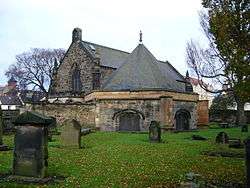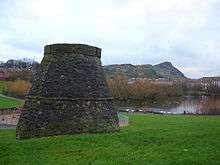Restalrig


Restalrig is a suburb of Edinburgh, Scotland (historically, an estate and independent parish). It is located east of the city centre, west of Craigentinny, and to the east of Lochend, with which it overlaps. Restalrig Road is the main route through the area, running from London Road, at Jock's Lodge, to Leith Links.
History and buildings
The place name Restalrig means ridge of the miry land (from lestal, a northern dialect term meaning mire and Old English hrycg, meaning ridge). It is first attested as Lastalri(c)k(e) in 1166, becoming variously Lestalryk, Restalric or Rastalrig.[1] The Norman noble family the de Lestalrics were the ancient landowners in the area (including nearby South Leith). Sir John de Lestalric died in 1382, leaving his estate to his daughter Katharine and her husband, Sir Robert Logan, who became the laird.[2]
The castle of the Logan family stood on the site of Lochend House, overlooking Lochend Loch. The castle was largely destroyed by fire in the late 16th century. The present house on the site incorporates fragments of the pre-existing tower house. Visually it is now dominated by an 1820 villa built on the foundations of the older buildings. It is now owned by the City of Edinburgh Council, and is a category B listed building.[3]
Lochend Loch below it was for many centuries the main water supply for Leith. The park which occupies the site of the now much reduced loch contains a 16th-century doocot at its northern end, sometimes speculated to have served as a kiln for burning infected clothing and belongings during the plague of 1645.[4] It was later used as a boat house, and is now also category B listed.[5]
According to Raphael Holinshed, Richard III of England camped at Restalrig in August 1482 after capturing Berwick upon Tweed.[6] James IV of Scotland was a frequent visitor, giving offerings for masses before the altars of Our Lady and Saint Triduana and for keeping Our Lady's Light in September 1496, while his gunners assembled the royal artillery nearby for his mission to England with the pretender Perkin Warbeck.[7]
During the Siege of Leith in Spring 1560, the headquarters of the English army was located at Restalrig Deanery near the kirk.[8] In April 1572 at the height of the Marian civil war, Thomas Randolph and Sir William Drury stayed in the Deanery. Sir William Kirkcaldy of Grange decorated the house with the royal tapestry from Edinburgh Castle.[9] The English ambassadors plotted with Archibald Douglas to kidnap George, Lord Seton from the shore of Leith, but the plan did not take effect.[10]
Around 1604, the Logans sold Calton and Restalrig, otherwise known as Wester and Easter Restalrig, to Lord Balmerino and the Craigentinny part of the estate to Edinburgh merchant James Nisbet.[11]
The most impressive remaining villa in the area is Marionville House, slightly west of the village centre. This has had numerous owners including Robert Dudgeon founder of the Royal Insurance Company. His son Patrick Dudgeon FRSE was born and raised here.[12]
By 1857, Restalrig had become what the ordnance gazetteer of Scotland called "a decayed village". The area was mostly farmland and dairies. Around 1925, public housing was built to the north and east. Restalrig House whose entrance was at Restalrig Drive/Restalrig Road South was demolished in 1963.[11]
Piershill Square at the head of Smokey Brae was built by the City Architect, Ebenezer James MacRae in 1937.[13] It replaced Piershill Barracks, the former home of the Royal Scots Greys, the cavalry regiment most famous for their charge at Waterloo, and the subject of the well-known, and much reproduced, head-on view painted by Elizabeth Thompson, "Scotland Forever!". The parish church at Waterloo contains several monuments specifically to various soldiers "of Restalrig".
St Ninian's RC Church on Marionville Road was designed in 1929 by Giles Gilbert Scott.[14] Within Restalrig are two multi-storey flats, Nisbet Court and Hawkhill Court. Both are owned by City of Edinburgh Council.
In 1784, the first British manned hot air balloon landed in Restalrig after taking off from nearby Abbeyhill.[11]
Restalrig Church
There has been a church at Restalrig as far back as 1178[11] and originally its parish incorporated South Leith. In 1296, Adam of St. Edmunds, the pastor of 'Restalric', swore fealty to English king Edward I.[15]
It is not known whether the church was built because of St. Triduana, but the church, a rectangular building, housed her relics, and her cult prospered under the patronage of James III of Scotland. He built a hexagonal chapel royal there, adjacent to the kirk, and endowed it a chaplaincy in 1477.[16] It became known as the King's Chapel. Payment for the roof was made in 1486-7. At the same time, he made the kirk a collegiate establishment called the Deanery of Restalrig, and initiated a programme of extension. Originally built on two levels, the surviving lower level of the hexagon was an undercroft for the chapel above. Sometimes referred to as a "well-house", this is probably a misnomer, the flooding being accidental. The lower aisle was used as a burial chamber for the Logan family.[17] James IV added six prebendaries and James V a choir of boys.[16]
The kirk was ordered to be removed in December 1560 at the time of the Scottish Reformation. Some parts of choir walls survived, however, until re-building of the church by William Burn in 1836.[17]
The church is a category A listed building. St. Triduana's Aisle is further protected as a Scheduled Ancient Monument.[18]
Notable interments in graveyard
- Robert Ord (1700-1778)
- Henry Brougham of Brougham Hall FRSE (1742-1810)
- Louis Cauvin (1754-1825), philanthropist
- Rev John Barclay (1758-1826), anatomist
- The Rev Thomas Rowland Wyer (1806-1891), Bishop of Glasgow and Galloway
- Thomas Murray (1792-1872), author
References
- ↑ "The Placenames of Midlothian" (PDF). Scottish Place-Name Society. Retrieved 2015-07-14.
|first1=missing|last1=in Authors list (help) - ↑ Marshall 1986, p. 4.
- ↑ "Lochend House, Listed Building Report". Historic Scotland. Retrieved 11 June 2010.
- ↑ "Lochend - Loch, Doocot and Plague Kiln". Geograph Britain and Ireland. Retrieved 2010-07-16.
- ↑ "Lochend Castle Doocot, Listed Building Report". Historic Scotland. Retrieved 11 June 2010.
- ↑ Holinshed, Raphael, The Scottish chronicle or, a complete history and description of Scotland, Arbroath (1805), pp.108-110
- ↑ Accounts of the Lord High Treasurer of Scotland, vol. 1, Edinburgh (1877), 296, 366.
- ↑ Calendar State Papers Scotland, vol. 1 (1898), 366.
- ↑ T. Thomson, ed., Diurnal of Occurrents, (Edinburgh, 1833), 291
- ↑ Calendar State Papers Scotland, vol. 4, (1905), p. 297
- 1 2 3 4 "Restalrig & Lochend". Edinburgh Past & Present. Retrieved 27 September 2014.
- ↑ BIOGRAPHICAL INDEX OF FORMER FELLOWS OF THE ROYAL SOCIETY OF EDINBURGH 1783 – 2002 (PDF). The Royal Society of Edinburgh. July 2006. ISBN 0 902 198 84 X.
- ↑ "Piershill Square, Listed Building Report". Historic Scotland. Retrieved 11 June 2010.
- ↑ The Buildings of Scotland: Edinburgh, by Colin McWilliam.
- ↑ Marshall 1986, p. 149.
- 1 2 Marshall 1986, p. 150.
- 1 2 MacIvor, Iain. "The King's Chapel At Restalrig and St Triduana's Aisle" (PDF). Retrieved 2012-06-18.
- ↑ "Historic Scotland - St Triduana's Aisle,chapel and wellhouse". Retrieved 2014-06-16.
Bibliography
- Marshall, J. M. (1986). The Life and Times of Leith. John Donald. ISBN 9780859761284.
External links
Coordinates: 55°57′35″N 3°09′02″W / 55.95972°N 3.15056°W
